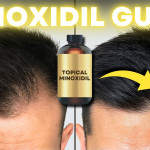Common and well-known treatment for hair regrowth, minoxidil has helped thousands of people worldwide fight baldness and thinning of their hair. Should you be experiencing hair loss, you have probably heard about Minoxidil and questioned whether it would be the appropriate fix for you. This comprehensive guide will walk you through how to properly use Minoxidil, what outcomes to expect, and the possible side effects.
What is Minoxidil?
One topical treatment that encourages hair growth and aids in reverse hair loss is minoxidil Originally taken orally to treat high blood pressure, Minoxidil was discovered to have the odd side effect of encouraging hair growth. Available in both liquid and foam forms, Minoxidil is today one of the most often used over-the-counter treatments for hair loss.
Commonly used to treat androgenic alopecia, or pattern baldness, minoxidil is efficient for men and women. It stimulates hair follicles, so increasing blood flow to the scalp and promoting hair growth.
How to Use Minoxidil for Hair Regrowth
To get the most out of Minoxidil and promote hair regrowth, it’s essential to apply it correctly. Here’s a step-by-step guide on how to use it:
1. Choose the Right Minoxidil Product
Minoxidil comes in two main concentrations:
- 2% Solution: Typically recommended for women or those who are new to Minoxidil.
- 5% Solution: Most commonly used for men and individuals with more advanced hair thinning.
Both products are available in either a liquid solution or foam form. While both are effective, some people find that foam is less messy and easier to apply.
2. Clean and Dry Your Scalp
Make sure your scalp is dry and clean before using minoxidil. After giving your hair a thorough wash, pat it dry with a towel. When Minoxidil is applied to a wet scalp, the product may become diluted and less effective.
3. Measure the Right Dose
One milliliter of minoxidil should normally be applied twice a day, in the morning and the evening. But it’s crucial to adhere to the dosage guidelines on the product’s packaging, or ask your doctor for personalized advice based on your needs.
- For Liquid Minoxidil: Use the dropper provided to apply 1 mL directly to the affected areas of your scalp.
- For Foam Minoxidil: Dispense the foam onto your fingers and gently massage it into the scalp.
4. Apply Minoxidil to the Affected Areas
Apply the solution sparingly to the hair loss areas. Concentrate on the areas with the most obvious thinning for optimal effects. Avoid using it on parts of your scalp where you are not experiencing hair loss.
Important: Keep minoxidil out of your mouth, eyes, and other delicate areas. Rinse with water right away if this occurs.
5. Allow Time for Absorption
After applying Minoxidil, allow the product to dry completely (usually around 2-4 hours). Avoid washing your hair or getting your scalp wet during this time.
6. Wash Your Hands Thoroughly
After applying Minoxidil, wash your hands thoroughly with soap and water to remove any leftover product.
Results You Can Expect from Minoxidil
When Will You See Results?
Patience is key when taking minoxidil. Most users will see noticeable changes in as little as two to four months, but full results may take six months to a year. You may experience some shedding in the early stages as weak, old hairs fall out to make room for new, stronger hair growth. The temporary shedding should be over in a few weeks.
What Kind of Results Can You Expect?
Minoxidil does not work for everyone, but many users experience significant improvements in hair density and regrowth. Some people may notice:
- Thicker hair
- Less noticeable bald spots
- Slower hair loss
For those with advanced baldness, Minoxidil can slow hair loss but may not be able to fully reverse baldness.
Maintaining Results
To maintain the results, Minoxidil must be used consistently. If you stop using it, hair loss will likely resume within several months, and the regrown hair may fall out.
Side Effects of Minoxidil
While Minoxidil is generally safe for most users, it can cause side effects in some individuals. It’s essential to be aware of these before starting treatment.
Common Side Effects:
- Scalp Irritation: Mild itching, redness, or dryness at the site of application.
- Unwanted Facial Hair Growth: Women who accidentally apply Minoxidil to areas such as the forehead or face may experience unwanted hair growth.
- Flaking or Dandruff: Some users may experience flaking of the scalp, which can be uncomfortable.
- Increased Hair Shedding: In the first few weeks of use, users may notice temporary hair shedding as old hairs fall out to make way for new growth.
Serious Side Effects (Rare):
- Chest Pain or Rapid Heartbeat: If you experience any chest discomfort or a noticeable change in heart rhythm, it’s crucial to seek medical attention immediately.
- Swelling of the Hands or Feet: This could be a sign of a more serious reaction, and you should contact a doctor if this occurs.
- Dizziness or Fainting: These symptoms may indicate an adverse reaction to Minoxidil and should be addressed immediately.
When to See a Doctor
See a medical expert if you have any severe side effects or if you are worried about the course of treatment. Before taking minoxidil, it’s wise to consult your doctor, particularly if you have any underlying medical issues.
Tips for Maximizing Minoxidil’s Effectiveness
To get the best results from Minoxidil, consider these additional tips:
- Be Consistent: Apply Minoxidil every day as directed, even if you’re not seeing immediate results. Consistency is key.
- Don’t Overuse: Applying more Minoxidil than recommended will not speed up the process and can increase the risk of side effects.
- Healthy Lifestyle: Maintain a balanced diet and stay hydrated. A healthy lifestyle can support hair growth and improve the effectiveness of treatments.
- Avoid Scratching: Itching can occur when using Minoxidil, but avoid scratching your scalp as this can cause irritation or damage to the skin.
Conclusion
One of the most successful over-the-counter treatments for hair regrowth is minoxidil, which, used correctly, can greatly increase the density and health of your hair. Although it might not be suitable for everyone, for those who react well to the treatment the outcomes can be transforming.
If you are thinking about using Minoxidil, keep in mind the possible side effects, be patient with the process, and closely follow the application directions. See a healthcare professional if you run across any problems to be sure Minoxidil is the best option for you.
Your chances of obtaining obvious hair regrowth will be highest if you keep constant and give your hair and scalp good care.










